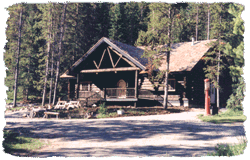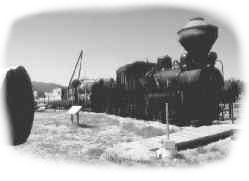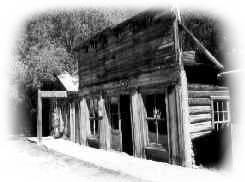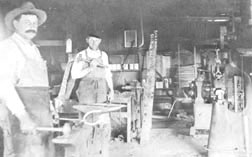

Before Ida Grove came to be, the Village of Ida was laid out in April, 1871 by John Moorehead, Charles Hathaway, and W.J. Wagner. It was north of the present Catholic church and consisted of sixteen blocks. When Ida was first situated north of Odebolt Creek, there was one sod house on the south side of the Odebolt at the SW corner of 2nd and Moorehead Streets.
 A schoolhouse was built on Block 10 of Ida in 1873, 24'x36' with one room on each floor. School started here November 20, 1873 with J.H. Aldrich as the teacher. It was used until 1907 when it was sold and moved to a farm in Silver Creek Township.
A schoolhouse was built on Block 10 of Ida in 1873, 24'x36' with one room on each floor. School started here November 20, 1873 with J.H. Aldrich as the teacher. It was used until 1907 when it was sold and moved to a farm in Silver Creek Township.
The first newspaper in Ida was the Ida County Pioneer. Because Robert Wilkinson had paid the freight on the new paper's equipment, he was given the honor of naming it, which he did in honor of the paper in his native Yorkshire, England. The first issue was printed March 3, 1872 in the second story of the courthouse.
The first doctor in the village was Dr. Frank Seeber, coming here in 1874. He added Dr. E.C. Heilman as a partner in 1877.
In March, 1877 there were 350 people in Ida and 1500 in Ida County.
 The first white people who came to Ida County were hunters and trappers. Edwin Smith and Marshall Townsley made claims at Ida Grove, June, 1854. In November, with six others, Smith and Townsley came from Smithland, staked out a road along the Maple River, and built a bridge across the river near the site of present day conservation headquarters in Moorehead Park. In the spring of 1855, they returned with their families. Townsley built his cabin on the west side of the Maple near Timber Creek, and Smith built his cabin on the east side of the Maple, at the north end of the present Moorehead Avenue. His daughter, Ida, was born there July 19, 1856, the first white child born in Ida County. The Townsleys left in the fall of 1855 for Sgt. Bluff and the Smiths left in the winter of 1856-57 for Smithland.
The first white people who came to Ida County were hunters and trappers. Edwin Smith and Marshall Townsley made claims at Ida Grove, June, 1854. In November, with six others, Smith and Townsley came from Smithland, staked out a road along the Maple River, and built a bridge across the river near the site of present day conservation headquarters in Moorehead Park. In the spring of 1855, they returned with their families. Townsley built his cabin on the west side of the Maple near Timber Creek, and Smith built his cabin on the east side of the Maple, at the north end of the present Moorehead Avenue. His daughter, Ida, was born there July 19, 1856, the first white child born in Ida County. The Townsleys left in the fall of 1855 for Sgt. Bluff and the Smiths left in the winter of 1856-57 for Smithland.
 The first permanent settlers were the Ebenezer Comstock family who arrived in May, 1856. They settled about four miles down the Maple River on Section 19 of Corwin Twp., paying $800 for 640 acres. Some descendants still reside in the county.
The first permanent settlers were the Ebenezer Comstock family who arrived in May, 1856. They settled about four miles down the Maple River on Section 19 of Corwin Twp., paying $800 for 640 acres. Some descendants still reside in the county.
In the spring of 1856, Mr. and Mrs. John H. Moorehead, their four children, and Mrs. Moorehead's mother, Mrs. Mary Good, left Iowa City to settle in Ida County. They were accompanied by a hired girl (Mary Mercer) and 3 workmen. They traveled in a three-seated buggy pulled by two teams of horses. Two large supply wagons loaded with supplies, furniture, clothing, tools, food, and a large medicine chest were each pulled by two yoke of oxen. At 10 miles per day, it took them about a month before they arrived at the Smith cabin on June 16, 1856.
 The Mooreheads moved into the Townsley cabin by Timber Creek at the site of the present Stagecoach Inn. By 1865, part of the house was rebuilt of lumber. Rooms were added until the present house with sixteen rooms was completed.
The Mooreheads moved into the Townsley cabin by Timber Creek at the site of the present Stagecoach Inn. By 1865, part of the house was rebuilt of lumber. Rooms were added until the present house with sixteen rooms was completed.
The Moorehead House served as home, hotel, church, courthouse, school, store, post office, and a stop on the stagecoach route.
 It is still possible to see the tracks left by the coaches through the park. Since travel was by "stages" (hence the name), the coaches stopped at settlements where passengers were fed, mail and packages were delivered and picked up, and horses were changed.
The Mooreheads kept at least 8 horses in their barn for the stages that stopped every day at noon from Sioux City and Fort Dodge.
It is still possible to see the tracks left by the coaches through the park. Since travel was by "stages" (hence the name), the coaches stopped at settlements where passengers were fed, mail and packages were delivered and picked up, and horses were changed.
The Mooreheads kept at least 8 horses in their barn for the stages that stopped every day at noon from Sioux City and Fort Dodge.
The first marriage in Ida County was in 1860 between Mary Mercer, who had come with the Mooreheads in 1856, and Henry Cleaveland.

IDA GROVE

By October, 1876 grading had started on the Maple River Railroad and by June, 1877 the grading had been finished from Ida to the junction with the Northwestern Railroad. In June, 1877 a map of the new town to succeed Ida, had arrived. It was located in Section 14, Township 87, Range 40, 3/4 mile south of the Village of Ida.
In its early days, Ida Grove had a 3-story roller mill,
 a business that made wire fence, a bottling works, a broom shop (operated by a blind man), a bicycle repair shop, a 3-story egg factory that preserved eggs
a business that made wire fence, a bottling works, a broom shop (operated by a blind man), a bicycle repair shop, a 3-story egg factory that preserved eggs
 for shipment to the East, a planing mill, a marble works, and a firm that made door and window frames. It also had a Turnverein Hall, two opera houses, several cigar makers, tinners, a wagon maker, a tree nursery, a neolite stone company, laundries, a roller rink, dairies, a book store, a bakery, and a music store.
for shipment to the East, a planing mill, a marble works, and a firm that made door and window frames. It also had a Turnverein Hall, two opera houses, several cigar makers, tinners, a wagon maker, a tree nursery, a neolite stone company, laundries, a roller rink, dairies, a book store, a bakery, and a music store.
The Pat Kee home at 310 Quimby, built by A.B. Bell in 1895 is on the National Register of Historic Places. It was a "kit" house, milled in Tennessee and shipped to Ida Grove to be assembled and built here by William Bassett. The Ida County Courthouse is also on the National Register of Historic Places. It was completed on November 30, 1883. J.P. Bryant, nephew of William Cullen Bryant, was the architect.
Two major industries, which do international business, have thrived in Ida Grove in the latter half of the 20th century:

and
GOMACO Corporation
[click here]

Originally built up separately by two local brothers (Byron Godbersen and the late Harold Godbersen, respectively), these 2 businesses now employ hundreds of people and continue to contribute to the growth and prosperity of the community of Ida Grove.
Perhaps the most famous person to come from Ida Grove is the late Harold E. Hughes

"Pack" Hughes (seen at right) became Governor of Iowa (1962 to 1968), and then a U.S. Senator (1969 to 1975). His book, "The Man From Ida Grove" can still be found in libraries across the globe. "Pack" Hughes was born on February 10, 1922, and passed away in 1996.
For an opinion piece on "addiction recovery" written by "Pack" Hughes in 1995, click HERE.
 BACK to Unofficial Ida Grove Home Page
BACK to Unofficial Ida Grove Home Page